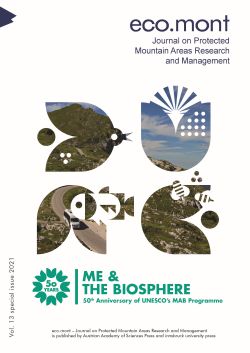
Eco.mont Vol. 13 special issue 2021, pp. 15-26, 2021/11/23
Journal on Protected Mountain Areas Research and Management

The biosphere reserve (BR), as conceived by UNESCO, is a permanent intervention towards sustainable development. With 727 BRs in 131 countries (Österreichisches MAB-Nationalkomitee 2021), this means interventions in highly diverse environmental, economic, socio-cultural and institutional contexts. With the MAB Strategy 2015–2025, the Lima Declaration 2016 and the Lima Action Plan 2016–2025, UNESCO BRs should develop fully into model regions for the implementation of the Sustainable Development Goals 2015–2030 (SDGs) (United Nations 2015). Because of their varied contexts, the UNESCO World Network of Biosphere Reserves consists of different, but globally self-similar, fractal institutions. In this article we emphasize the understanding, implementation and management of BRs in Germany, Austria and Switzerland. These three European democracies are examples of federally structured states with comparatively wealthy economies as well as high political stability. Respect for property rights, regional acceptance, decentralized decisionmaking, and micro- and macro-economic considerations have always played decisive roles in the development of BRs in the DACH countries. We aim to identify, analyse and discuss the distinct characteristics and peculiarities of BRs in this area. We investigate how the framework conditions of sustainability, as presented in the concept of BRs, are perceived, discussed and implemented. As a basis for our analysis, we use a sample of 18 peer-reviewed publications, which were published collectively as a book on BRs in the DACH countries (Borsdorf et al. 2020). The individual publications present overviews, case studies and in-depth investigations in the three countries. All authors were invited to participate in a meta-text analysis. This was conducted in the form of a survey, a transdisciplinary workshop with a reflective design using a virtual whiteboard, and a concluding feedback loop. The results of the qualitative exploration are interpreted against the background of international comparisons and recent scholarly discussions. Based on the assumption that different types of ambiguities and conflicts are inherently a key element of the BR concept, we conclude that the DACH countries may have found specific ways to deal with and overcome these differences.
Keywords: UNESCO MAB-Programme, biosphere reserve, governance, sustainability, Austria, Germany, Switzerland